Potential for deep geothermal energy in Scotland: study volume 2
This independent study investigates the potential for deep geothermal energy in Scotland and the steps necessary for commercialisation.
4 Geothermal data for Scotland
Heat flow is the standard measure of the amount of heat travelling through Earth's crust. As such, heat flow measurements have been used as the basis for all previous assessments of geothermal energy potential in Scotland. Unfortunately, the heat flow dataset for Scotland is relatively small, and no new values have been reported since the 1980s. Furthermore, the values are (as noted in section 2.1.4) subject to a range of factors that reduce the degree to which they can be assumed to provide an accurate indication of the size of the geothermal resource at depth. Making a significant step forward in our understanding of the deep geothermal energy potential in Scotland therefore requires either more heat flow data coupled with a better understanding of the factors that affect heat flow measurements, or an alternative means of assessing the size and distribution of the heat resource.
Temperatures measured directly in boreholes provide the best currently available alternative source of heat data. Available temperature data measured in onshore boreholes were collated and reported by Burley et al. (1984). The vast majority of the boreholes from which temperature data have been obtained were drilled for reasons other than geothermal energy assessment (usually oil/gas/coal exploration), and the data have not previously been evaluated in a geothermal energy context.
The heat flow and borehole temperature datasets for Scotland are reviewed in this section. Although this assessment of geothermal energy potential in Scotland is limited to onshore areas, temperature data obtained from offshore boreholes are included in the review because they increase the size of the dataset and extend the depth range of measured temperature data, thereby improving the confidence with which onshore data can be extrapolated to greater depths.
There are only thirty-five published heat flow values for Scotland ( Table 3), all of which derive from onshore boreholes ( Figure 4). Thirty-four of them are collated in the BGS Catalogue of Geothermal Data for the UK (Burley et al., 1984). The heat flow values range from 29 to 82 mW m -2; the mean is 56 mW m -2 and the median is 57 mW m -2. The geographical spread of the data, and contours derived from them, are shown in Figure 4 and Figure 5 together with the borehole names that appear in Table 3. The sparseness of the dataset is such that closed contours (indicating the location of apparent 'hot spots') are formed in only two areas: in the central part of the Midland Valley, where a 60 mW m -2 contour encloses a cluster of values; and in the East Grampians region, where a 70 mW m -2 contour encloses a cluster of values derived from granite intrusions. The 50 mW m -2 contour in the East Grampians area has been extended tentatively to the west to intersect a cluster of values in Loch Ness. Most of the reported heat flow values derive from measurements made at depths of less than 400 metres below ground surface.
The following comments concern the degree to which these measurements can be considered to reflect accurately the size of the heat resource at depth.
- Nine values are from boreholes drilled into lake sediment on the floor of Loch Ness. The published values include significant corrections ( e.g. for seasonal temperature variations in the water), so their reliability and the degree to which they can be compared meaningfully with values measured in solid rock are not clear; they should probably be treated with caution. Loch Ness overlies a major discontinuity in the crust, the Great Glen Fault, which may act to focus or disperse heat locally; the data therefore may not be a good indicator of regional background heat flow.
- Four values come from boreholes in radiogenic ( HHP) granite in the East Grampians region, so these will be influenced by a local Heat Production component and will therefore not be a good indicator of regional background heat flow. These data are reviewed in more detail in section 8.2.
- Fifteen values are from boreholes sited in sedimentary rocks of Carboniferous and/or Devonian age. Of these, thirteen occur in geographical clusters: three are in Caithness (Achanarras, Houstrie of Dunn, Yarrows); three are close to Glenrothes in Fife (Glenrothes, Balfour, Boreland); and seven are in and around Glasgow (Clachie Bridge, South Balgray, Blythswood, Kipperoch, Barnhill, Hurlet, Maryhill). The two others are geographically isolated (Montrose, Marshall Meadows). The temperature of these sedimentary rocks may have been affected by large-scale convective transfer in groundwater, therefore it is unclear to what extent the heat flow measurements represent background heat flow values.
- The remaining seven measurements (from the Altnabreac A, Altnabreac B, Ballachulish, Meall Mhor, Tilleydesk and Castle Douglas boreholes, and an unnamed borehole on the east shore of Loch Fyne) were made in metamorphosed rocks that are not obviously affected by locally elevated Heat Production. Crystalline rocks lack intergranular porosity, and it has been generally assumed that they are 'dry' at deep levels and heat transfer is essentially conductive. However, a growing body of evidence suggests crystalline rocks may also be affected to some degree by convective heat transfer in fracture-hosted groundwater. A value of 29 mW m -2 from the Tilleydesk (Ellon) borehole in Aberdeenshire is included in Burley et al. (1984) but was never formally reported by the Oxford University Heat Flow group that recorded it, presumably because it is a suspect value (as suggested by Lee et al., 1984); it is anomalously low, and cannot be considered a reliable indicator of background heat flow. With this value excluded from the heat flow dataset the mean value for all heat flow data for Scotland rises slightly to 57 mW m -2.
- As noted previously ( section 2.1.4), in all parts of Scotland the geothermal gradient in the near-surface zone is likely to be perturbed by climate warming since the last glaciation. For this reason, and for the variety of other reasons described above, the existing set of heat flow values for Scotland and the contours derived from them to produce the heat flow map ( Figure 4 and Figure 5) almost certainly do not provide an accurate indication of the size and distribution of the heat resource at depth.
Table 3 Heat flow data for Scotland. All data from Burley et al. (1984), except Glenrothes borehole from Brereton et al. (1988). 'East Midland Valley' includes all boreholes in National Grid Reference 100 km squares NO and NT. 'West Midland Valley' includes all boreholes in National Grid Reference 100 km square NS. Grid references for most boreholes are presented in Table 4. See Figure 4 for borehole locations.
| Region | Borehole name | Heat flow density ( mW m -2) |
|---|---|---|
| Caithness | Altnabreac A | 43 |
| Caithness | Altnabreac B | 53 |
| Caithness | Achanarras | 42 |
| Caithness | Houstrie of Dunn | 45 |
| Caithness | Yarrows | 52 |
| Loch Ness | 1 | 73 |
| Loch Ness | 2 | 64 |
| Loch Ness | 3 | 62 |
| Loch Ness | 4 | 57 |
| Loch Ness | 5 | 82 |
| Loch Ness | 6 | 67 |
| Loch Ness | 7 | 55 |
| Loch Ness | 8 | 43 |
| Loch Ness | 9 | 43 |
| East Grampians | Tilleydesk (Ellon) | 29 |
| East Grampians | Cairngorm | 70 |
| East Grampians | Bennachie | 76 |
| East Grampians | Mt Battock | 59 |
| East Grampians | Ballater | 71 |
| Argyll | Ballachulish | 53 |
| Argyll | Meall Mhor | 57 |
| East Midland Valley | Montrose | 46 |
| East Midland Valley | Balfour | 37 |
| East Midland Valley | Boreland | 40 |
| East Midland Valley | Glenrothes | 56 |
| East Midland Valley | Marshall Meadows | 51 |
| East Midland Valley | Livingston | 62 |
| West Midland Valley | Clachie Bridge | 55 |
| West Midland Valley | South Balgray | 72 |
| West Midland Valley | Blythswood | 59 |
| West Midland Valley | Kipperoch | 54 |
| West Midland Valley | Barnhill | 60 |
| West Midland Valley | Hurlet | 60 |
| West Midland Valley | Maryhill | 63 |
| Dumfries & Galloway | Castle Douglas | 61 |
Figure 4 An early version of the heat flow map of the UK (from Lee et al., 1984; Figure 7.2). Black dots denote heat flow measurement localities. Names are boreholes referred to in Table 3. The locations of the Archerbeck and Lothbeg boreholes, which are not sites of heat flow measurement but are mentioned in section 7.4 and in Table 4, are also shown.
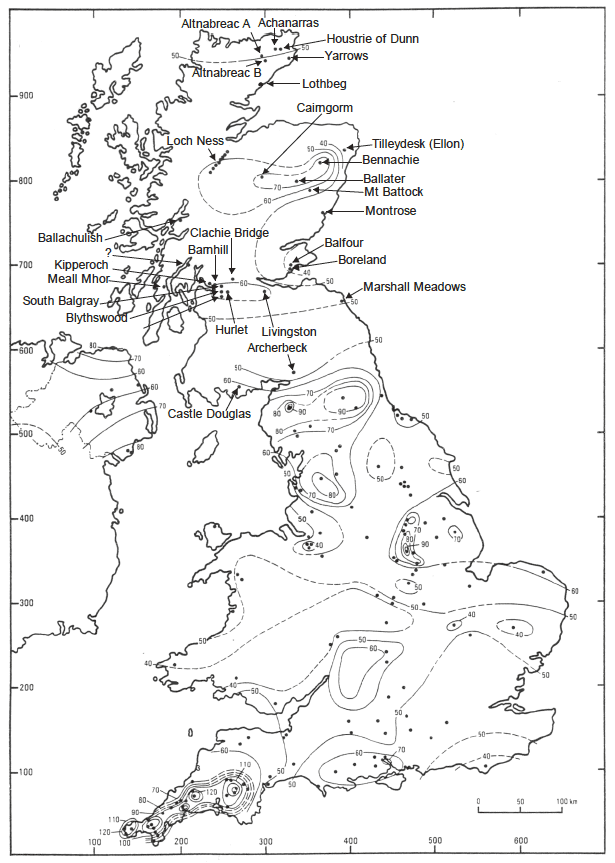
Figure 5 Colour-contoured heat flow map of the UK, based on the Geothermal Map of the UK ( BGS, 1986; this version from Busby, 2010).
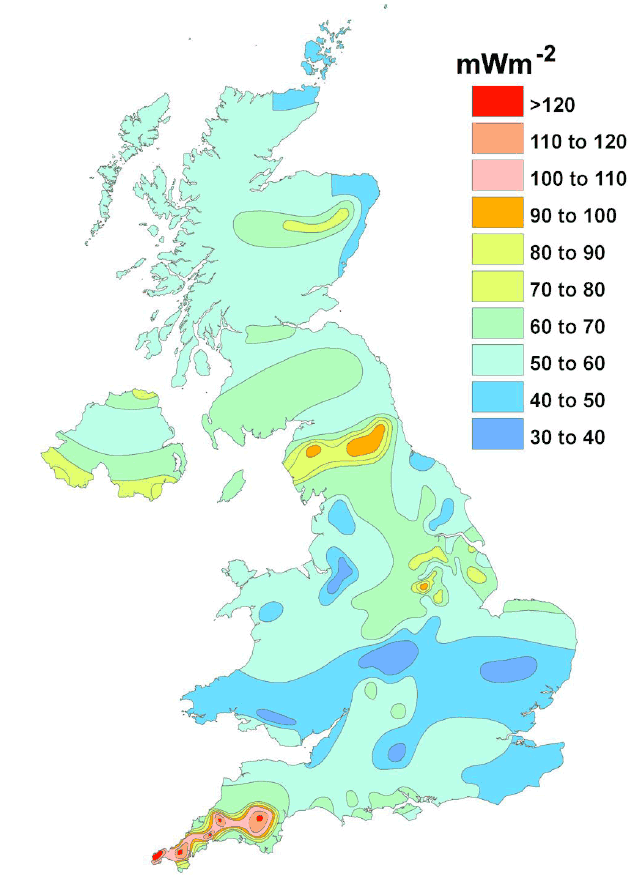
4.2.1 Temperature data from onshore boreholes
The BGS Catalogue of Geothermal Data for the UK (Burley et al., 1984) includes a list of borehole temperature data for sixty-one boreholes in onshore parts of Scotland; these include many of the boreholes from which heat flow values have been calculated. In most cases, the temperature measurement has been made at, or near to, the bottom of the borehole. Whereas most of the available heat flow data come from depths of less than 400 metres below ground surface, the onshore borehole temperature data extend to a depth of around 1,300 metres. Unfortunately, they are clustered mainly in Caithness, the East Grampians region, and particularly in the Midland Valley, and so do not significantly extend the spatial coverage of onshore geothermal data beyond that provided by the heat flow dataset.
Temperature data for onshore boreholes in Scotland are summarised in Table 4. An average temperature gradient has been calculated for each borehole using the surface temperature, the borehole temperature, and the depth at which the latter was measured. The range of average temperature gradient values for all sixty-one boreholes extends from 3.7 to 45.0 ºC/km; the mean is 22.5 ºC/km, and the median is 21.5 ºC/km.
The wide range of average temperature gradient values suggests that the gradient in any one borehole is affected by a range of local factors (some combination of those described in sections 2.1.4 and 4.1). However, plotted together as temperature versus depth (T-z) the data display a trend defining a temperature gradient of 30.5 ºC/km that persists throughout the entire depth range ( Figure 6).
Figure 6 Bottom-hole temperature vs depth (T-z) data for onshore boreholes in Scotland. The trend of the data follows a temperature gradient of approximately 30.5 ºC/km (solid white line). The dotted white line is an extrapolation of the solid line, intersecting the 'surface' at 4ºC. Dashed white lines define the limits within which most of the data scatter around the centre line. See section 7.4 for a description of the Lothbeg and Archerbeck data.
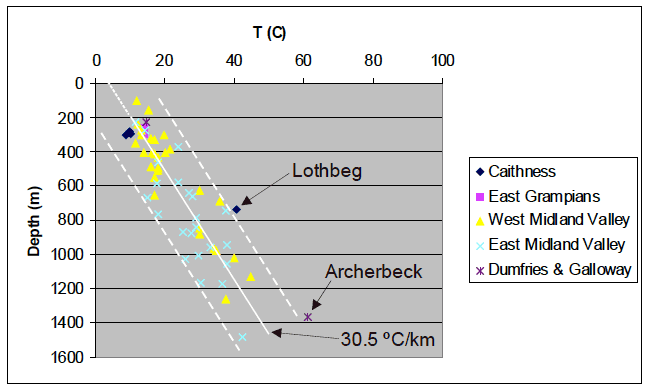
Table 4 Temperature-depth data for onshore boreholes in Scotland.
| Borehole name | Region | Grid reference | Source | Depth | Temp | T grad | Type |
|---|---|---|---|---|---|---|---|
| Altnabreac | Caithness | NC 9990 4528 | BGS | 299 | 10.3 | 7.4 | LOG |
| Altnabreac | Caithness | NC 9939 4291 | BGS | 301 | 8.8 | 3.7 | LOG |
| Altnabreac | Caithness | ND 0232 4167 | BGS | 282 | 10.1 | 7.1 | LOG |
| Lothbeg No.1 | Caithness | NC 946 095 | PCO | 736 | 40.6 | 42.9 | BHT |
| Bennachie | East Grampians | NJ 6690 2110 | BGS | 294 | 14.0 | 20.1 | BHT |
| Mt Battock | East Grampians | NO 543 905 | BGS | 263 | 14.0 | 22.1 | BHT |
| Ballater | East Grampians | NO 4000 9850 | BGS | 296 | 14.0 | 19.6 | BHT |
| Rashiehill | West Midland Valley | NS 8386 7301 | BGS | 964 | 34.4 | 26.2 | LOG |
| Clachie Bridge | West Midland Valley | NS 6447 8368 | BGS | 300 | 13.2 | 16.0 | LOG |
| Salsburgh | West Midland Valley | NS 8166 6486 | GAS | 883 | 30.0 | 24.1 | BHT |
| Hallside | West Midland Valley | NS 6694 5975 | BGS | 350 | 11.8 | 6.0 | LOG |
| Grangemouth | West Midland Valley | NS 9513 8387 | NCB | 1134 | 45.0 | 30.9 | BHT |
| South Balgray | West Midland Valley | NS 50 75 | BEN | 160 | 15.3 | 45.0 | EQM |
| Blythswood | West Midland Valley | NS 5003 6823 | BEN | 105 | 12.0 | 37.1 | EQM |
| Douglas Colliery | West Midland Valley | NS 830 300 | NCB | 239 | 12.2 | 14.2 | MWT |
| Solsgirth Colliery | West Midland Valley | NS 9777 9329 | NCB | 387 | 21.5 | 31.0 | MWT |
| Bogside Colliery | West Midland Valley | NS 9564 8778 | NCB | 334 | 17.0 | 22.2 | MWT |
| Highhouse Colliery | West Midland Valley | NS 5321 7202 | NCB | 436 | 18.0 | 19.5 | MWT |
| Barony Colliery | West Midland Valley | NS 5105 1971 | NCB | 411 | 17.0 | 19.0 | MWT |
| Killoch Colliery | West Midland Valley | NS 4883 2130 | NCB | 655 | 17.0 | 11.9 | MWT |
| Polkemmet Colliery | West Midland Valley | NS 9190 6278 | NCB | 549 | 17.0 | 15.5 | MWT |
| Eggerton | West Midland Valley | NS 8504 3171 | NCB | 410 | 14.0 | 13.2 | BHT |
| Tillicoultry | West Midland Valley | NS 9276 9653 | NCB | 510 | 18.0 | 15.9 | BHT |
| Tullibody | West Midland Valley | NS 8601 9594 | NCB | 325 | 16.0 | 18.8 | BHT |
| Cartlove | West Midland Valley | NS 9403 9267 | NCB | 404 | 16.6 | 16.3 | BHT |
| Gartenkeir | West Midland Valley | NS 9267 9486 | NCB | 488 | 16.0 | 15.0 | BHT |
| Shannock Hill | West Midland Valley | NS 9338 9512 | NCB | 497 | 18.0 | 19.9 | BHT |
| Pipersink | West Midland Valley | NS 9307 8911 | NCB | 408 | 20.2 | 25.5 | BHT |
| Glenochill | West Midland Valley | NS 8769 9617 | NCB | 628 | 30.0 | 32.0 | BHT |
| Queenslie | West Midland Valley | NS 6466 6598 | NCB | 691 | 36.0 | 38.4 | BHT |
| Slatehole | West Midland Valley | NS 4906 2342 | NCB | 1024 | 40.0 | 29.8 | BHT |
| Gallowknowe | West Midland Valley | NS 8388 3118 | NCB | 1261 | 37.5 | 22.8 | BHT |
| Stoneyknowes | West Midland Valley | NS 8817 3570 | BGS | 277 | 13.5 | 18.1 | BHT |
| Craighead | West Midland Valley | NS 8267 6212 | TAW | 977 | 35.0 | 27.2 | BHT |
| Maryhill | West Midland Valley | NS 5718 6856 | IC6 | 303 | 20.0 | 34.0 | EQM |
| Comrie | West Midland Valley | NS 9787 9501 | NCB | 850 | 30.0 | 24.1 | VST |
| Glenrothes | East Midland Valley | NO 2561 0314 | BGS | 279 | 14.4 | 28.1 | EQM |
| Balfour | East Midland Valley | NO 323 003 | BEN | 1205 | 33.4 | 19.8 | EQM |
| Windygates | East Midland Valley | NO 3510 0034 | NCB | 1298 | 30.0 | 16.1 | BHT |
| Spilmersford | East Midland Valley | NT 4570 6902 | BGS | 877 | 27.8 | 20.9 | BHT |
| Midlothian | East Midland Valley | NT 363 647 | ESO | 747 | 37.8 | 39.1 | LOG |
| Birnieknowes | East Midland Valley | NT 7580 7317 | BGS | 372 | 23.9 | 39.2 | LOG |
| Marshall Meadow | East Midland Valley | NT 9797 5686 | IC5 | 227 | 11.5 | 10.6 | EQM |
| Cousland No.5 | East Midland Valley | NT 3774 6773 | BP | 585 | 17.8 | 15.0 | BHT |
| Cousland No.6 | East Midland Valley | NT 3835 6801 | BP | 582 | 23.9 | 25.6 | BHT |
| Pumpherston | East Midland Valley | NT 0733 6979 | BP | 1175 | 36.7 | 23.3 | BHT |
| Lochead | East Midland Valley | NT 3219 9659 | NCB | 1167 | 30.4 | 17.7 | BHT |
| Boreland | East Midland Valley | NT 3040 9420 | AND | 1007 | 29.8 | 20.1 | EQM |
| Mackies Mill | East Midland Valley | NT 3050 9795 | NCB | 960 | 33.3 | 24.6 | BHT |
| Thornton Bridge | East Midland Valley | NT 2889 9722 | NCB | 665 | 28.0 | 27.5 | BHT |
| Thornton Farm | East Midland Valley | NT 2969 9761 | NCB | 1055 | 38.0 | 26.8 | BHT |
| Eastfield | East Midland Valley | NT 3264 7297 | NCB | 1028 | 26.0 | 15.6 | BHT |
| Bilston Glen Colliery | East Midland Valley | NT 2996 6320 | NCB | 670 | 15.0 | 8.7 | MWT |
| Lady Victoria Colliery | East Midland Valley | NT 3294 6666 | NCB | 768 | 18.0 | 10.8 | MWT |
| Auchendinny | East Midland Valley | NT 2496 6125 | NCB | 459 | 18.0 | 19.6 | BHT |
| Wellsgreen | East Midland Valley | NT 3342 9833 | NCB | 1485 | 42.3 | 22.0 | LOG |
| Livingston | East Midland Valley | NT 018 691 | OX3 | 640 | 27.0 | 28.1 | EQM |
| Stewart | East Midland Valley | NT 3633 6476 | LAS | 942 | 37.9 | 34.9 | BHT |
| Frances | East Midland Valley | NT 3214 9050 | NCB | 841 | 29.0 | 23.8 | VST |
| Monktonhall | East Midland Valley | NT 3242 7053 | NCB | 866 | 25.5 | 18.2 | VST |
| Seafield | East Midland Valley | NT 3150 8923 | NCB | 789 | 29.0 | 25.3 | VST |
| Castle Douglas | Dumfries & Galloway | NX 717 550 | OX5 | 231 | 14.7 | 23.8 | EQM |
| Archerbeck | Dumfries & Galloway | NY 4157 7815 | BGS | 1365 | 61.2 | 37.9 | LOG |
All data are from Burley et al. (1984), except Glenrothes which is from Brereton et al. (1988). 'East Midland Valley' includes all boreholes in National Grid Reference 100 km squares NO and NT. 'West Midland Valley' includes all boreholes in National Grid Reference 100 km square NS. BGS = British Geological Survey, PCO = Premier Consolidated Oilfields, GAS = British Gas Corporation (as was), NCB = National Coal Board (as was), BEN = Benfield (1939), TAW = Taylor Woodrow Energy (as was), IC6 = Wheildon et al. (1984), ESO = Esso, IC5 = pers. comm. (to Burley et al., 1984) from J Wheildon, BP = British Petroleum (as was), AND = Anderson (1940), OX3 = Bloomer et al. (1979), LAS = Lasmo, OX5 = Oxburgh (1982). Depths are in metres measured from the ground surface; temperatures are in ºC; T grad = temperature gradient, in ºC/km. Type: LOG = T measured during geophysical logging; BHT = bottom-hole temperature; EQM = equilibrium temperature; MWT = mine water temperature; VST = virgin strata (= equilibrium) temperature. Full descriptions of these terms and the reliability of the associated measurements are given in Burley et al. (1984). Surface temperatures for each borehole, which are required to calculate T grad, are given in Burley et al. (1984).
When extrapolated, the best-fit line through all the data intersects the 'surface' (0 metres on the depth axis of Figure 6) at approximately 4.0ºC; this is significantly below the current annual average surface temperature in Scotland (taken to be 9.0ºC, which is the average of all the surface temperature data listed in Burley et al. (1984) for the boreholes included in Table 4). This implies that the top end of the geothermal gradient (the part that is typically measured in shallow boreholes) is not simply a continuation of the deeper trend; the gradient must steepen ( i.e. the rate of increase in temperature with depth will appear to be smaller) in the near subsurface. The geothermal gradient measured in the near-subsurface will therefore be lower than the temperature gradient defined by all the borehole temperature data (30.5 ºC/km). Hence, measurements of the geothermal gradient made in individual shallow boreholes are likely to underestimate the actual geothermal gradient at depth. It follows that heat flow values calculated using these geothermal gradient data will underestimate the size of the heat resource at depth.
4.2.2 Temperature data from offshore boreholes
Most of the boreholes in offshore parts of Scotland have been drilled by hydrocarbon exploration companies; such boreholes are typically referred to as wells. Bottom-hole temperature ( BHT) data from seventy-two wells drilled into thirteen 'sectors' on the North West Margin of the UK continental shelf are compiled in Gatliff et al. (1996). The location of the wells and sectors is shown in Figure 7. Details of the sectors and well numbers, corrected [2] bottom-hole temperatures
Figure 7 Well and sector locations in the North West Margin. From Gatliff et al. (1996).
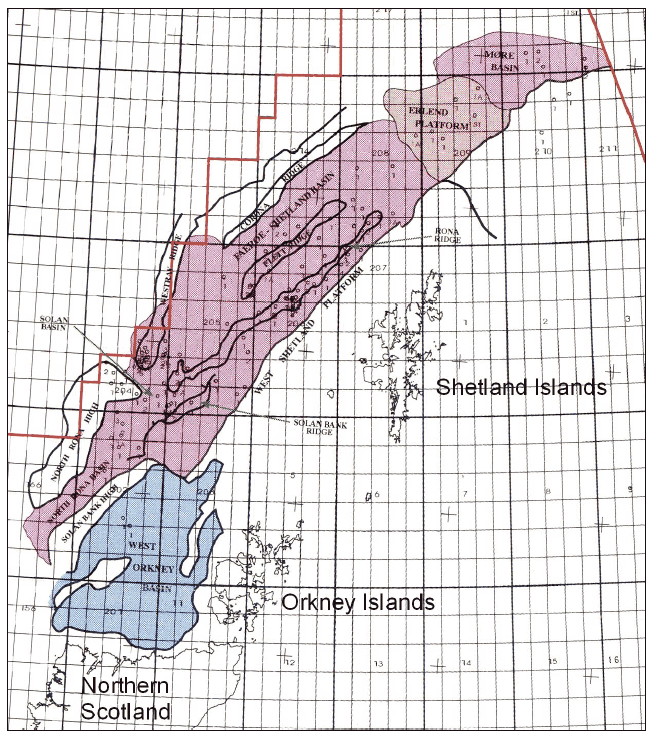
Figure 8 Bottom-hole temperature versus depth (T-z) data for offshore wells in the North West Margin. (a) Data plotted according to sector. (b) Data plotted according to structural setting (structurally 'low' geological basins and structurally 'high' ridges and platforms).
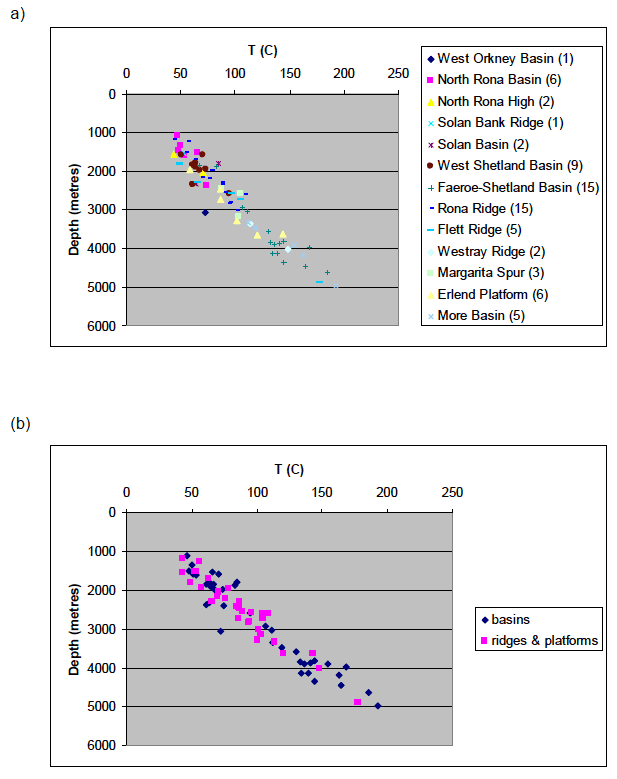
Table 5 Bottom-hole temperature and depth data for offshore wells in the North West Margin region. Data from Gatliff et al. (1996). Depths are measured from the sea bed.
| Sector | Well no. | T (ºC) | Depth (m) | Seabed T (ºC) | T grad ( ºC/km) |
|---|---|---|---|---|---|
| West Orkney Basin | 202/19-1 | 72.1 | 3065 | 9 | 20.6 |
| North Rona Basin | 202/2-1 | 46.6 | 1094 | 9 | 34.4 |
| 202/3-1A | 53.2 | 1612 | 9 | 27.4 | |
| 202/3-2 | 49.9 | 1347 | 9 | 30.4 | |
| 202/3A-3 | 74.3 | 2384 | 9 | 27.4 | |
| 202/8-1 | 66.1 | 1538 | 9 | 37.1 | |
| 202/9-1 | 47.9 | 1493 | 9 | 26.1 | |
| 204/28-1 | 43.2 | 1565 | 8 | 22.5 | |
| North Rona High | 204/29-1 | 70.7 | 2046 | 9 | 30.2 |
| Solan Bank Ridge | 205/27A-1 | 52.8 | 1538 | 9 | 28.5 |
| Solan Basin | 204/30-1 | 84.9 | 1801 | 9 | 42.1 |
| 205/26A-2 | 63.7 | 2322 | 9 | 23.6 | |
| West Shetland Basin | 205/20-1 | 63.7 | 1801 | 9 | 30.4 |
| 205/23-1 | 94.8 | 2585 | 9 | 33.2 | |
| 205/25-1 | 61.3 | 2363 | 9 | 22.1 | |
| 205/30-1 | 67.2 | 1981 | 9 | 29.4 | |
| 206/13-1 | 51.2 | 1576 | 9 | 26.8 | |
| 207/1-2 | 70.4 | 1584 | 9 | 38.8 | |
| 207/2-1 | 64 | 1892 | 9 | 29.1 | |
| 208/23-1 | 61.5 | 1854 | 9 | 28.3 | |
| 208/24-1A | 73.6 | 1962 | 9 | 32.9 | |
| Faeroe-Shetland Basin | 205/16-1 | 168.5 | 3964 | 9 | 40.2 |
| 206/1-2 | 136.6 | 3884 | 3 | 34.4 | |
| 206/2-1A | 141.2 | 3872 | 3 | 35.7 | |
| 206/3-1 | 185.6 | 4626 | 9 | 38.2 | |
| 206/5-1 | 132.9 | 3838 | 9 | 32.3 | |
| 206/11-1 | 144.5 | 4354 | 9 | 31.1 | |
| 208/17-1 | 139.5 | 4123 | 3 | 33.1 | |
| 208/19-1 | 106.2 | 2928 | 9 | 33.2 | |
| 208/21-1 | 111.2 | 3038 | 8 | 34.0 | |
| 208/22-1 | 83 | 1878 | 9 | 39.4 | |
| 208/26-1A | 130.3 | 3581 | 9 | 33.9 | |
| 214/27-1 | 144.5 | 3805 | 3 | 37.2 | |
| 214/27-2 | 66.7 | 1845 | 3 | 34.5 | |
| 214/28-1 | 164.3 | 4460 | 3 | 36.2 | |
| 214/29-1 | 134 | 4119 | 8 | 30.6 | |
| Rona Ridge | 205/21-1A | 42.9 | 1184 | 9 | 28.6 |
| 205/22-1A | 101.9 | 3027 | 9 | 30.7 | |
| 206/8-1A | 69.5 | 2163 | 9 | 28.0 | |
| 206/8-2 | 63.1 | 1720 | 9 | 31.5 | |
| 206/8-3 | 84.8 | 2416 | 9 | 31.4 | |
| 206/8-4 | 94.4 | 2848 | 9 | 30.0 | |
| 206/8-5 | 78.4 | 1970 | 9 | 35.2 | |
| 206/8-6 | 89 | 2560 | 9 | 31.3 | |
| 206/8-7 | 76 | 2200 | 9 | 30.5 | |
| 206/9-1 | 109.2 | 2612 | 9 | 38.4 | |
| 206/9-2 | 87.3 | 2297 | 9 | 34.1 | |
| 206/10A-1 | 95 | 2826 | 9 | 30.4 | |
| 206/12-1 | 54.3 | 1537 | 9 | 29.5 | |
| 206/12-2 | 87.3 | 2364 | 9 | 33.1 | |
| 207/1-1 | 56.6 | 1251 | 9 | 38.0 | |
| Flett Ridge | 205/10-1A | 49.1 | 1815 | 8 | 22.6 |
| 205/10-2 | 177.9 | 4900 | 8 | 34.7 | |
| 205/10-3 | 65.5 | 2294 | 8 | 25.1 | |
| 206/1-1A | 96.7 | 2578 | 8 | 34.4 | |
| 214/30-1 | 105 | 2748 | 8 | 35.3 | |
| Westray Ridge | 204/19-1 | 148.1 | 4023 | 3 | 36.1 |
| 204/23-1 | 113.3 | 3349 | 8 | 31.4 | |
| Margarita Spur | 210/4-1 | 87.1 | 2462 | 9 | 31.7 |
| 210/5-1 | 105.2 | 2600 | 9 | 37.0 | |
| 210/13-1 | 103.2 | 3159 | 10 | 29.5 | |
| Erlend Platform | 208/15-1A | 86.2 | 2733 | 9 | 28.2 |
| 209/3-1A | 58.1 | 1953 | 9 | 25.1 | |
| 209/4-1A | 120.5 | 3637 | 9 | 30.7 | |
| 209/6-1 | 143.6 | 3629 | 9 | 37.1 | |
| 209/9-1 | 86.2 | 2447 | 9 | 31.5 | |
| 209/12-1 | 101.3 | 3279 | 9 | 28.1 | |
| Møre Basin | 219/20-1 | 162.8 | 4187 | 5 | 37.7 |
| 219/27-1 | 112.1 | 3335 | 9 | 30.9 | |
| 219/28-2 | 118.8 | 3466 | 8 | 32.0 | |
| 220/26-1 | 193.1 | 4961 | 9 | 37.1 | |
| 220/26-2 | 154.3 | 3902 | 9 | 37.2 |
( CBHT), depths below seabed and temperature at seabed are presented in Table 5, along with calculated values for the average temperature gradient in each well. The data span a depth range from 1,094 to 4,961 metres below the sea bed, by far the deepest and greatest depth range for published geothermal data in any part of Scotland. The range of average temperature gradient values for individual wells is 20.6 to 42.1 ºC/km; the mean is 31.9 ºC/km, and the median is 31.5 ºC/km.
As with the equivalent data from onshore boreholes, the wide range of average temperature gradient values suggests that the gradient in any one well is affected by a range of local factors. However, plotted together in temperature-depth (T-z) space the data define a clear trend that spans the entire depth range ( Figure 8 a,b), from which the following observations can be made:
- the trend is defined equally clearly by wells representing single sectors and wells representing all sectors;
- the trend is the same for wells drilled into geological 'highs' (ridges and platforms) and geological 'lows' (basins);
- the trend is not straight; its shape is probably best characterised as a gentle curve denoting increasing temperature gradient with depth;
- the temperature gradient for the top part of the trend (defined by data extending down to c. 3.5 km) is approximately 36 ºC/km, while for the bottom part (defined by data below c. 3.5. km) it is approximately 47 ºC/km;
- the trend suggests a temperature of ~190ºC would be encountered at a depth of 5 km across the North West Margin.
Gatliff et al. (1996) provided geological details for fifteen of the wells. This subset includes at least one representative from all thirteen sectors of the North West Margin, with the exception of the Margarita Spur sector. All of the wells intersect a thick sequence of sedimentary rocks, representing every period of geological time from the Devonian (c. 400 million years ago) to the Quaternary (present day) period. Most of the wells terminate in sedimentary (cover) rocks, but three of the fifteen wells terminate in crystalline basement rocks.
4.2.3 Combined temperature data for onshore boreholes and offshore wells
Plotted together, the temperature-depth (T-z) data for onshore boreholes and offshore wells define a single, linear trend that extends from the near-surface down to 5 km ( Figure 9). The following observations can be made.
- None of the 133 data points lie significantly off the trend, raising the possibility that a consistent regional temperature gradient exists beneath much (possibly all) of Scotland.
- The relatively modest amount of scatter displayed by the data is noteworthy, considering the variety of geological settings, the geographical extent of the data (c. 900 km from north to south), the lack of a common datum for depth measurements (onshore depths are calculated with respect to ground surface and offshore depths with respect to the sea bed), and the range of factors that can influence heat supply and transfer.
- The temperature range defined by the data at any one depth is never greater than 46ºC, and this range is broadly consistent at all depths ( Figure 9).
- If the centre-line of the trend is taken to represent a regional temperature gradient, the ~46ºC temperature range at any one depth represents the maximum net effect of inaccuracies in temperature measurements and variations in surface elevation, borehole equilibration time, thermal conductivity, climate change signal, convective heat transfer, background heat supply and locally generated heat.
- The consistency of the trend and limited scatter of the data suggests that the temperature at any given depth down to 5 km can be predicted with a precision of approximately ±23 ºC. In other words, the pattern of background heat flow beneath Scotland may be relatively simple and largely predictable.
- The temperature gradient defined by all the data is not constant ( i.e. a straight line), but increases with depth. The gradient is probably best described as a curve, but on Figure 9 it is divided into three best-fit straight-line segments for which separate geothermal gradients can be calculated. In the top 1.5 km the gradient is approximately 30.5 ºC/km, between 1.5 and 3.5 km it is 35.8 ºC/km and between 3.5 and 5 km it is 46.7 ºC/km.
- Compaction of sedimentary rocks should increase their thermal conductivity, hence the geothermal gradient in sedimentary rocks should, in general, decrease with increasing depth if the heat flow profile is consistent.
- The apparen T gradual increase in geothermal gradient with depth is not easily explained. Climate warming since the last glaciation (see section 2.1.4) may account (at least in part) for a lower geothermal gradient in the shallowest part of the curve, while the proximity of some offshore areas to the continental margin (where the crust may be thinner and heat flow therefore may be higher) may account (at least in part) for a higher geothermal gradient in the deepest part of the curve.
- The trend is defined by data from boreholes and wells that penetrate a range of rock types and structural regimes both onshore and offshore, and is essentially continuous throughout the zone in which the deepest onshore data and shallowest offshore data overlap; this suggests the regional temperature gradient may be broadly the same in both onshore and offshore settings.
Figure 9 Combined onshore and offshore bottom-hole temperature vs depth data. Solid white, blue and yellow lines represent the centre line of the averaged geothermal gradient in three depth ranges, 0-1,500, 1,500-3,500 and 3,500-5,000 metres respectively. Dashed white, blue and yellow lines mark the approximate limits of the data scatter to either side of the centre line. The red double-headed arrow marks the depth at which the temperature data are most widely scattered; the arrow spans a temperature range of ~46°C.
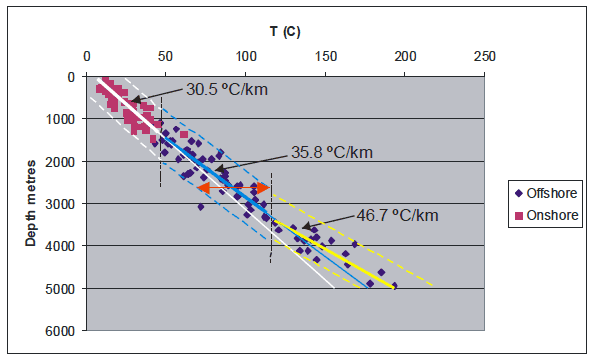
Much of onshore Scotland is underlain by crystalline rocks. Unfortunately, there are very few temperature data from crystalline rocks in onshore parts of Scotland, and none from deeper than 300 metres below ground surface. However, sixteen of the wells forming the North West Margin dataset terminated in the crystalline (basement) rocks that underlie the sedimentary (cover) rocks. The bottom-hole temperatures in these wells therefore represent temperature data for crystalline rocks. The T-z trends for wells that terminate in crystalline basement rocks and wells that terminate in non-crystalline (sedimentary) cover rocks are essentially identical ( Figure 10), suggesting the regional temperature gradient extends unperturbed across the basement-cover interface.
Figure 10 Bottom-hole temperature versus depth (T-z) data for offshore wells in the North West Margin, distinguishing those that terminated in non-crystalline (sedimentary cover) and crystalline (igneous or metamorphic basement) rocks.
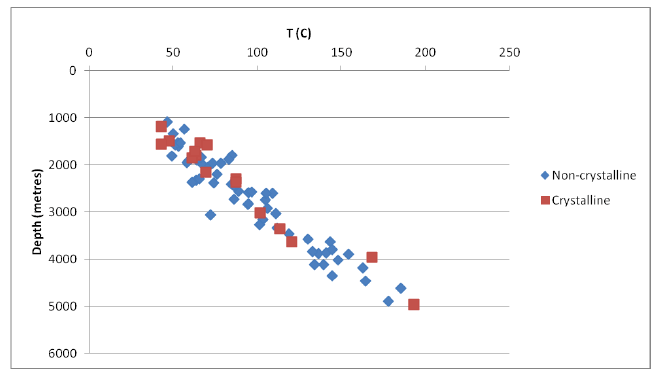
Even if onshore settings do not follow the higher temperature gradient of offshore settings below 1.5 km, the gradient of 30.5 ºC/km defined by the data from onshore boreholes suggests temperatures could be around 150ºC at 5 km depth in onshore areas. The gradient for onshore data is defined mainly by boreholes in the Midland Valley, so the level of confidence attached to an extrapolation to 5 km is highest for that area. The extrapolation must carry a lower level of confidence for other onshore areas for which there are temperature data (Caithness, East Grampians and Dumfries & Galloway), because there are fewer data for these areas and they span a relatively shallow depth-range. None of the data for these areas lies significantly off the trend so there is currently no indication that the regional temperature gradient outside the Midland Valley is significantly different from that within it. However, sedimentary basins (such as the Midland Valley) commonly form as a result of the crust being stretched, which means the crust beneath sedimentary basins can be relatively thin and therefore heat flow can be higher than in adjacent areas underlain by thicker crust.
Contact
There is a problem
Thanks for your feedback